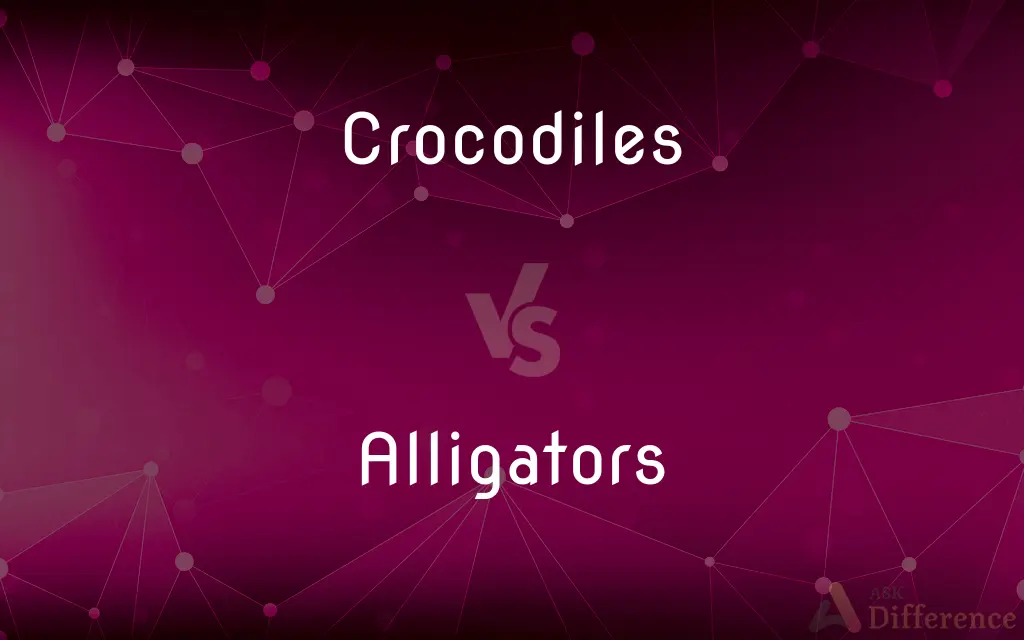Crocodiles vs. Alligators — What's the Difference?
By Tayyaba Rehman & Maham Liaqat — Published on March 5, 2024
Crocodiles and alligators, while similar, differ in their snout shape, habitat preferences, and behavior, with crocodiles being more aggressive and saltwater-tolerant.

Difference Between Crocodiles and Alligators
Table of Contents
ADVERTISEMENT
Key Differences
Crocodiles and alligators are often confused due to their physical similarities, but several key differences distinguish them. Crocodiles possess a V-shaped, narrower snout and are generally more aggressive than alligators. They also have a higher tolerance for saltwater due to specialized glands that excrete excess salt, allowing them to inhabit both freshwater and saltwater habitats. Alligators, with their U-shaped, wider snouts, are primarily found in freshwater environments. Their snouts are designed for crushing prey, suited to their diet of fish, birds, and mammals.
In terms of visibility of teeth, crocodiles' fourth tooth is visible when their mouth is closed, unlike alligators, whose teeth are not visible in this state due to a more concealed jawline. This feature is one of the easiest ways to differentiate the two at a glance. Crocodiles also tend to have a lighter, more olive-brown coloration, while alligators appear darker, usually black or gray.
Geographically, crocodiles are found in Africa, Asia, the Americas, and Australia, showcasing their adaptability to various environments. Alligators are mainly located in the United States (specifically Florida and Louisiana) and China. Behaviorally, crocodiles are considered more dangerous to humans, attributed to their aggressive nature, while alligators tend to be more docile, though still capable of posing a threat if provoked.
Despite these differences, both belong to the order Crocodylia and share many traits, such as being apex predators with powerful jaws, keen senses, and a remarkable ability to adapt to their environments. Conservation efforts continue for both species, addressing threats like habitat destruction and illegal hunting, highlighting their ecological importance.
Comparison Chart
Snout Shape
V-shaped, narrower
U-shaped, wider
ADVERTISEMENT
Aggressiveness
Generally more aggressive
Relatively more docile
Saltwater Tolerance
High, can live in both freshwater and saltwater
Primarily freshwater dwellers
Teeth Visibility
Fourth tooth visible when mouth is closed
Teeth not visible when mouth is closed
Coloration
Lighter, olive-brown
Darker, usually black or gray
Habitat
Africa, Asia, Americas, Australia
United States (Florida, Louisiana), China
Danger to Humans
Considered more dangerous
Less dangerous but can be aggressive
Compare with Definitions
Crocodiles
Possess a narrower, V-shaped snout.
The crocodile's V-shaped snout is adept at catching fish.
Alligators
Mainly inhabit freshwater environments.
Alligators are commonly seen in Florida's freshwater rivers and lakes.
Crocodiles
More aggressive by nature.
Crocodiles are known for their bold behavior towards humans and other animals.
Alligators
Less aggressive compared to crocodiles.
Alligators tend to avoid humans and are less likely to attack.
Crocodiles
Can live in both freshwater and saltwater.
Crocodiles are often found in estuaries and mangrove swamps.
Alligators
Feature a wider, U-shaped snout.
The alligator's broad snout is effective for crushing shellfish.
Crocodiles
Found in a wider geographic range.
Crocodiles inhabit regions from Africa to Australia.
Alligators
Teeth are not visible when mouth is closed.
The alligator's teeth fit neatly inside its mouth, concealing them from view.
Crocodiles
Fourth tooth visible when mouth is closed.
You can see the crocodile's fourth tooth even when its jaws are shut.
Alligators
Primarily found in the US and China.
The American alligator is a well-known resident of the southeastern United States.
Crocodiles
Any of various large aquatic reptiles of the family Crocodylidae that are native to tropical and subtropical regions and have thick, armorlike skin and long tapering jaws.
Alligators
Either of two large semiaquatic reptiles, Alligator mississipiensis of the southeast United States or A. sinensis of China, having sharp teeth and powerful jaws. They differ from crocodiles in having a broader, shorter snout.
Crocodiles
A crocodilian reptile, such as an alligator, caiman, or gharial.
Alligators
Leather made from the hide of one of these reptiles.
Crocodiles
Leather made from crocodile skin.
Alligators
A tool or fastener having strong, adjustable, often toothed jaws.
Crocodiles
Chiefly British A line of people, especially pupils or choir members, standing two abreast.
Alligators
Plural of alligator
Crocodiles
Plural of crocodile
Common Curiosities
How do crocodiles and alligators regulate their body temperature?
Being ectothermic, they regulate their body temperature through basking in the sun to warm up and seeking shade or water to cool down.
Which is more dangerous to humans, crocodiles or alligators?
Crocodiles are considered more dangerous due to their more aggressive nature and broader habitat range, including human-populated areas.
What do crocodiles and alligators eat?
Their diet includes fish, birds, and mammals, but it can vary widely based on their size and available prey in their habitat.
What is the largest species of crocodile and how big can it get?
The saltwater crocodile is the largest, capable of reaching lengths of over 20 feet.
Why are crocodile conservation efforts important?
Crocodiles play a crucial role in maintaining the balance of their ecosystems as apex predators; their conservation helps preserve biodiversity.
Can crocodiles and alligators interbreed?
No, they belong to different families and genera, making them genetically incompatible for breeding.
How can I safely observe crocodiles or alligators in the wild?
Maintain a safe distance, avoid feeding them, and observe from designated viewing areas or with a guided tour.
How long have crocodiles and alligators been on Earth?
They are ancient animals, with ancestors dating back over 200 million years, making them living dinosaurs.
Can alligators survive in saltwater?
Alligators have limited saltwater tolerance and primarily stick to freshwater habitats, though they can occasionally venture into brackish waters.
Are there any successful conservation stories for crocodiles or alligators?
The American alligator is a conservation success story, having recovered from near extinction to being removed from the endangered species list.
Share Your Discovery

Previous Comparison
Diphenhydramine vs. Doxylamine
Next Comparison
Physiotherapy vs. ChiropracticAuthor Spotlight
Written by
Tayyaba RehmanTayyaba Rehman is a distinguished writer, currently serving as a primary contributor to askdifference.com. As a researcher in semantics and etymology, Tayyaba's passion for the complexity of languages and their distinctions has found a perfect home on the platform. Tayyaba delves into the intricacies of language, distinguishing between commonly confused words and phrases, thereby providing clarity for readers worldwide.
Co-written by
Maham Liaqat















































